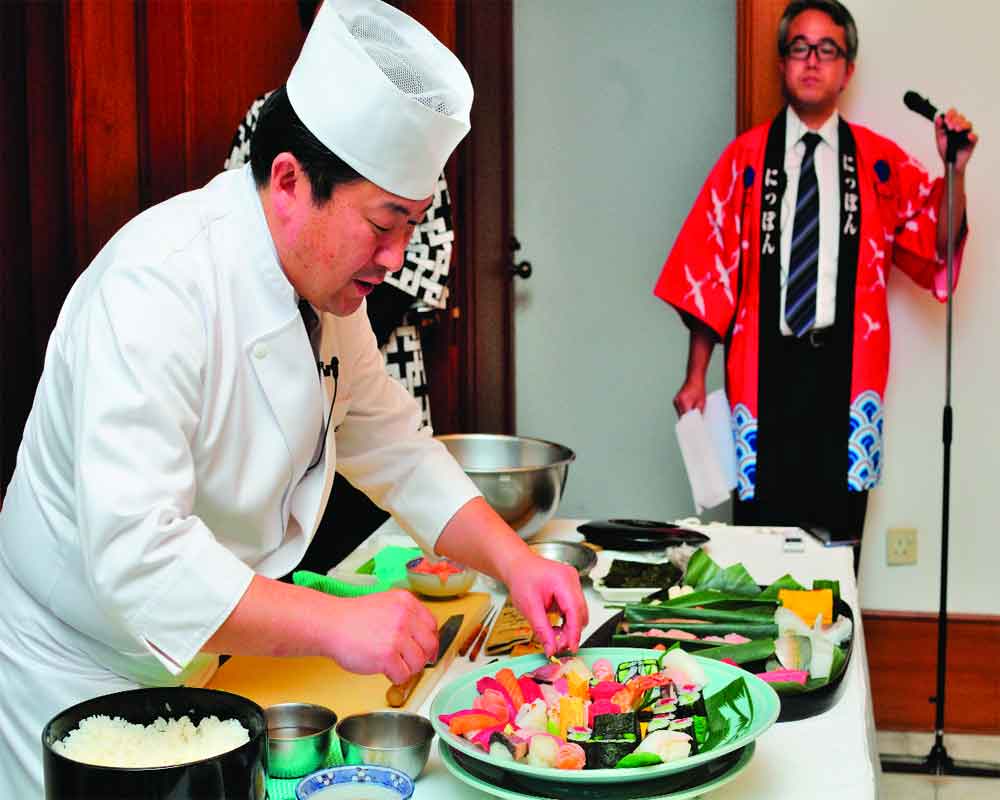An evening with Japanese food and sake made it evident why the cuisine is becoming popular among Indian millennials, says Ayushi Sharma
A huge wooden cask bound with metal hoops lies in the centre amid a crowd of people at the Embassy of Japan. The barrel is about to be hit with a wooden hammer. I, then, get to know that it’s the traditional Kagami Biraki ceremony, which marks the start of something new in the country. The term literally translates as “opening the mirror” or “breaking of the mochi,” in which a cask of sake is opened. Thereby, the evening with ‘Japanese food and sake’ begins.
The enormous hall has 10 counters, five on each side. There are different varieties of food and flavours of sake, all from the land of the rising sun. The very first counter that attracts me is that of the Spinach paneer rice. Greens, proteins and carbohydrates, all in one. What else do we need for an easy mid-week dinner? It has fresh baby spinach leaves and unlike the Indian rice, the grains are too sticky and clumpy. One might think that it doesn’t match the authentic Indian taste but I wouldn’t question its claim to being a fusion — quite the perfect one.
I, then, take a sip from their signature series of sake, which include the Black, the Silver and the Gold. The Black is a pure style of sake with white mountain flowers, the scent of which seems to perfume the olfactory permanently. It has a soft, silky texture. I can sense the subtle fruitiness with hints of mango, peach and pineapple. The Silver is an aromatic Ginjo sake with honeysuckle on the nose and floral notes of cherry blossoms. It makes a good impact on the palate with notes of mango, Asian pear and honeydew melon. This, too, has a smooth finish. Last, the Gold is flagship of their core Enter.Sake line. It surely has notes of melon and peach. The sake connoisseurs share that the supple body of this one originates from the pure mountain water, filtered through the Japanese Alps. They say that while drinking sake one has to let the aroma sink in first. It has to touch your senses and exhilarate your tastebuds before you swallow it. Well, I try. But I can’t resist and sip it all in one go.
The very next moment, I find myself indulging into Veggie pepper rice — another offering which suddenly makes me realise that this isn’t the last dish I am tasting which has rice in it this evening. The dish has plump pearls of rice coated with their signature margarine, sauces, finely-ground pepper, crunchy corns and medley of capsicum, button mushroom, broccoli, onions and baby corns. I feel, nothing gives more flavour to the food than fresh ingredients. And here, I can actually experience the natural flavours of each and every ingredient of the dish.
Next up is Hatozaki, a Japanese blended whisky, aged up to 12 years in a barrel with a minimum malt whisky content of 40 per cent. This one has cereal notes, mild sweetness and is quite light in taste, which allows it to be used in both highball and straight pours.
Moving on to the next counter, there is Indian Masterchef Pankaj Bhadouria, who has prepared some dishes, too, inspired by the Japanese cuisine. She says that during her recent trips to Japan, she was introduced to all these new ingredients, which have inspired the menu. It consists of — Matcha tea phirni, Wasabi khandavi, Tamari-marinated shrimp appa, Apple slaw and Togarashi makhani sauce. She tells us, “The process is Indian and the ingredients are from Japan. Getting back from Japan and doing a bit of experiment led me to this epic fusion. I feel Japanese food is getting really popular among Indians because of the millennials, who are quite experimental in their approaches.” By the time I reach her counter, almost all the dishes are finished. I am sure it’s because they were too good to abstain from.
The last range of sakes — quirky and fresh — from Ozeki Corporation, Hana Awaka, are the best. There are three sparkling flavours — flower, peach and yuzu (lime). Well, the first certainly reminds one of that sweet, bubbly Italian white wine, Moscato d’Asti. It is floral, lightly sparkling and juicy. Second, the Sparkling peach, is infused with peach juice. It is something that surpasses ever other sparkling drink. Another jewel reminds me of the champagne. The sparking yuzu is a low-alcohol sake, infused with citrus fruit for a refreshing taste. The distinguished aroma of yuzu blends perfectly with the mouthful of fruitiness.
Certainly, such an evening made it quite evident why the Japanese culture and cuisine is becoming popular among Indian millennials.
Photo: Pankaj Kumar


























